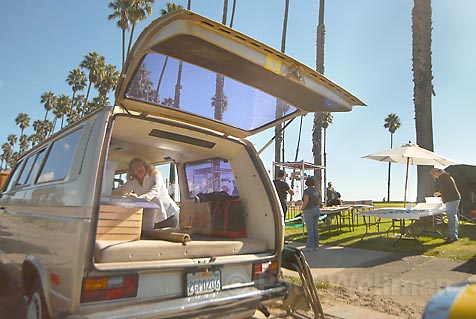New Cabrillo Sidewalk Moving Forward
Where Landscaping and Art Collide

Here, Williams shows the logistics of unloading for the art show.
After a lengthy debate pitting the historic grand plans drawn up years ago for Cabrillo Boulevard against the present-day operational needs of the artists and craftspeople who sell their wares every Sunday on Santa Barbara’s beachfront, members of the Santa Barbara City Council came down on the side of the historians, while seeking a few extra inches on behalf of the vendors. Translated into plain English, that means the council voted to reject the appeal of City Hall’s plan to renovate a mile-long stretch of Cabrillo Boulevard between State and Milpas streets. While art show representatives strongly endorsed plans for a new sidewalk, they adamantly opposed the city’s plans to landscape the ribbon of dirt now running between the curb and the sidewalk, arguing it will pose a safety hazard for exhibitors as they unloaded their wares and will reduce public access to the park.
Members of the city’s Historic Landmarks Commission (HLC) have repeatedly and emphatically endorsed the landscaping plans, arguing that they were first drawn up in the 1920s by the nationally renowned urban planning firm of Olmsted and Cheney (firm cofounder Frederick Law Olmsted designed New York’s Central Park). According to a historical consultant hired by the city’s Redevelopment Agency, the proposed landscaping element constituted “a character-defining feature of the Historic District,” which in turn exemplified “the most significant example of town planning in Santa Barbara which helped preserve the City’s most prominent beach from private development.” But the artists and artisans, led by Marilyn Loperfido, claimed the landscaping would make it considerably more difficult, if not positively unsafe, for roughly half the show’s 130 craft exhibitors to unload their goods. Loperfido argued the Olmsted plans said nothing about the landscaping and complained that the city’s proposed plantings would stand 18 inches high when mature and effectively block two out of every four cars. Furthermore, Loperfido argued the plans worked out by City Hall to accommodate unloading constitute a safety hazard because inadequate space is provided for unloading exhibits.
The plans call for 24 inches of hardscaped surface running between the curbs and the landscaping. Loperfido asked that number be increased to 33. In denying the appeal, a council majority suggested that the hardscaped area be increased. But they also made it clear they wouldn’t push for more space if doing so jeopardized the approval they needed from the California Office of Historic Preservation. City planners countered that they’d already removed more than 50 percent of potential landscaping in deference to the arts and crafts exhibitors, and that the state might frown on further reductions.
Compounding matters, Loperfido noted that city police have just reversed their 10-year policy of allowing exhibitors to park along a 500-foot-long stretch of red-painted curb. While this change is not part of the landscaping plan, it came about as a result of city discussion of that plan. Councilmembers agreed to look into returning 40 feet of the curb by painting it yellow. They also agreed to investigate whether one lane could be temporarily blocked off on Sundays to accommodate the artists’ loading and unloading needs.
“This is a classic case of no good deed going unpunished,” lamented Councilmember Brian Barnwell. He and Councilmember Roger Horton were instrumental in securing the $3.1 million in bond funds necessary to replace the 80-year-old stretch of deteriorating sidewalk nearly four years ago. The project quickly became a classic Santa Barbara historical shootout, however, when it was discovered that the State of California regarded that picturesque stretch of road as historically significant. While the original Olmsted plans do not specify what kind of plants should be included in the dirt median separating pedestrians from the roadway, they definitely call for landscaping.
Most of the combatants in this quagmire concede that for the past 40 years, the dividing strip alternated from hard-packed dirt to mud. Architect Bill LaVoie of the HLC acknowledged the dividing strip has been nothing but dirt for a very long time. “But that’s kind of an embarrassment to the city,” LaVoie said, noting that great efforts were made to accommodate the exhibitors during the six HLC hearings on the matter. Breaks and openings were designed into the proposed landscaping design to allow exhibitors to move from the curb to the sidewalk unimpeded. “We’ve compromised to meet the needs of people who use that area for half a day a week,” he said. “How about them accommodating the rest of us who use that area the other six and a half days?” Likewise, city Redevelopment staff insisted some of the criticisms leveled by art show advocates are overstated. Of the 18,000 square feet of plantable space, staffers contended only 7,000 square feet will actually be landscaped.



